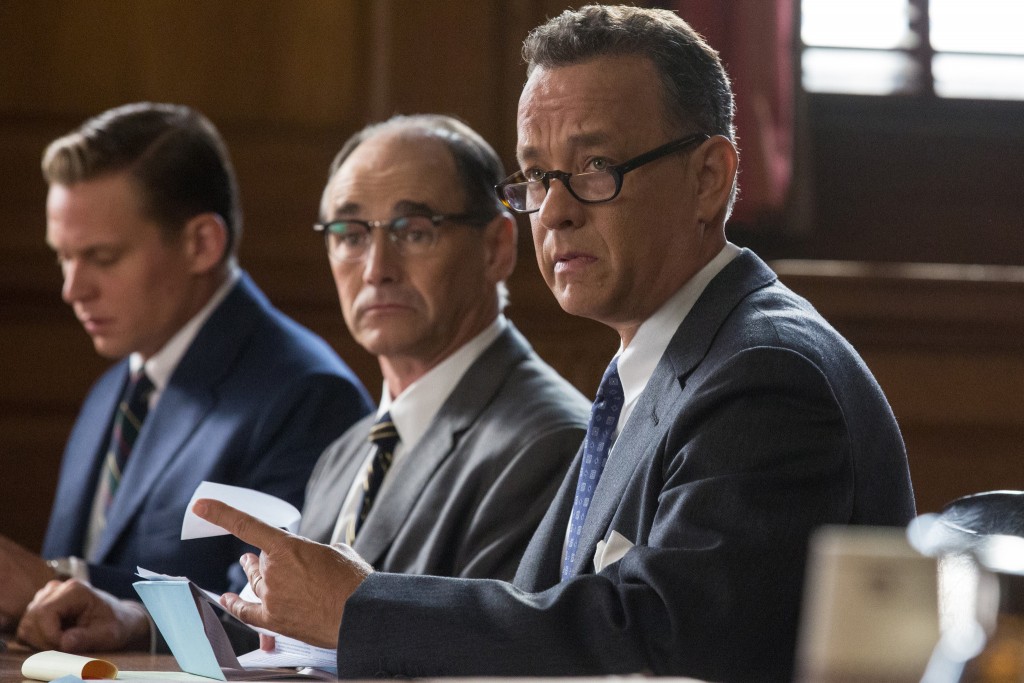Rugged Individualism, by Tyler Smith
16 Oct
Steven Spielberg’s Bridge of Spies is a very good- sometimes great- movie about the importance of seeing people as they are, rather than what they represent. That this is couched in a Cold War spy story makes this theme all the more resonant. For decades, the United States and the Union of Soviet Socialist Republics were engaged in a non-violent war of ideologies. This war often manifested itself as a constant scramble for information; about weapons, about technology, about pretty much anything. Paranoia was at an all-time high, with special attention paid to those that could be spies for the other side, infiltrating our ranks and selling our secrets.
In this tense environment, we get Rudolf Abel (played enigmatically by Mark Rylance), a mild-mannered painter living in New York. Abel is soon outed as a Soviet spy and promptly arrested. The United States government, attempting to keep up the appearance of due process, assigns a straight-laced insurance lawyer named James Donovan (Tom Hanks) to defend Abel. Donovan does this to the best of his ability; he’s so thorough, in fact, that even those that picked him are wondering why he’s trying so hard. This was always more about perception than a legitimate trial.
Nonetheless, Donovan works his hardest, growing closer to Abel as a result. He doesn’t see Abel as a traitor, or even a bad person. He is merely working for his country, just as anybody would. This defense is not tolerated and Abel is found guilty. However, soon enough, Abel is used as a bargaining chip, as the Russians have a captive U.S. pilot that they’d like to trade. Donovan travels to West Germany to broker the deal, and is soon faced with the stark differences between the U.S.S.R. and his home country.
Donovan is a decent man, and is played by our most inherently decent actor. The way Tom Hanks carries himself is reminiscent of Jimmy Stewart in his various collaborations with Frank Capra. He exudes intelligence and humility. And the film around him feels very much the same way. There is a visual quality to the film that makes us feel like we aren’t necessarily looking at the way things were, but are instead looking at the way we remember things to be. The men are all impeccably dressed, with the nicest of those old 1950s cars. Everything is neat and tidy. We are watching the essence of these things more than the things themselves.
This makes for a film that is notably beautiful. In fact, perhaps things are a bit too beautiful. Eventually, it becomes hard to connect with this world. As well-conceived as it may be, it doesn’t feel like a world that we can walk around in and explore. It’s too insulated and polished. It’s like a stuffed lion on display at a museum; it’s majestic to look at, but that’s all you can really do with it. It’s not a living, breathing thing. The sets look like sets and the costumes look like costumes. It bears a resemblance to the world we live in, but its falseness keeps us at arm’s length.
But perhaps this was Spielberg’s design. This is a film less interested in trying to capture the era as much as trying to invoke our collective memories of that era. So, instead of accurate photographs, we get a world inspired by the paintings of Norman Rockwell and Edward Hopper. All so that we can feel safe and secure, as though we have nothing new to learn and are just going to hang out for a while in an era that we are all very comfortable in. Spielberg uses the pristine visuals to lure us in, only to then hit us with a message that we are not prepared for.
As the film began, a part of me was worried that Spielberg- working from a script co-written by Joel and Ethan Coen – would work to draw similarities between the United States and Soviet Russia. And while both countries had their share of paranoia- culminating in the shameful McCarthy Era in the U.S. – students of history are well acquainted with the particular brutality and oppression that went on in Russia at the time. While no ideology is perfect, some are more successful than others, and Spielberg spends a good portion of the second half of the film examining just how tense and oppressive the Soviet Union could be.
But, thankfully, this is not merely a film that points out the advantages of being an American. That would be far too simple, and ultimately uninteresting. This is about something deeper than America. It is about American values; specifically the idea that more than any group or populace, the most important aspect of society is the individual. Whether it be Abel and his strength and loyalty in the face of extreme opposition, or Donovan and his commitment to doing what’s right, even when those around him encourage him to compromise, Bridge of Spies argues that there are righteous people in every society, no matter how rigid and tyrannical.
It is an exciting idea and one that is often lost in the modern age of identity politics, where the groups you belong to are what define you infinitely more than your actions. And while the film does turn a bit simplistic as it goes on – both thematically and artistically, with the United States bathed in warm, autumnal colors and the Soviet Union cold, white, and uninviting – the message is clear: a person is more than the sum of where they are from, what color they are, their sex, or any of the other things we use to divide ourselves up. Each person is a complex combination of belief, passion, effort, and love. And as long as we’re able to see one another as people more than as representations, connections can be made and bridges can be built.




No comments yet